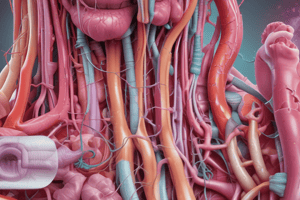Podcast
Questions and Answers
Which of the following is NOT a possible cause of upper gastrointestinal (GI) disease?
Which of the following is NOT a possible cause of upper gastrointestinal (GI) disease?
- Neoplastic (correct)
- Vascular
- Traumatic
- Infective
What are the common symptoms of upper GI disease?
What are the common symptoms of upper GI disease?
- Headache and dizziness
- Chest pain and shortness of breath
- Fever and chills
- Heartburn and indigestion (correct)
What is the possible consequence of recurrent damage over time in upper GI disease?
What is the possible consequence of recurrent damage over time in upper GI disease?
- Muscle hyperplasia
- Formation of strictures
- Development of mutations leading to malignancy (correct)
- All of the above
Which of the following is a common symptom of oesophageal adenocarcinoma?
Which of the following is a common symptom of oesophageal adenocarcinoma?
What is the most common type of tumour in the oesophagus?
What is the most common type of tumour in the oesophagus?
Which risk factor is not associated with an increased risk of oesophageal adenocarcinoma?
Which risk factor is not associated with an increased risk of oesophageal adenocarcinoma?
What is the characteristic histological feature of oesophageal adenocarcinoma?
What is the characteristic histological feature of oesophageal adenocarcinoma?
Which of the following is a major complication of reflux?
Which of the following is a major complication of reflux?
What is the main cause of a sliding hiatal hernia?
What is the main cause of a sliding hiatal hernia?
Which of the following is a characteristic feature of Barrett oesophagus?
Which of the following is a characteristic feature of Barrett oesophagus?
What is the main cause of eosinophilic oesophagitis?
What is the main cause of eosinophilic oesophagitis?
Which of the following conditions is characterized by the dilation of subepithelial and submucosal venous plexuses within the distal esophagus and proximal stomach?
Which of the following conditions is characterized by the dilation of subepithelial and submucosal venous plexuses within the distal esophagus and proximal stomach?
Which of the following conditions is characterized by reflux symptoms that occur at least once a week, including acid reflux and dyspepsia?
Which of the following conditions is characterized by reflux symptoms that occur at least once a week, including acid reflux and dyspepsia?
Which of the following conditions is characterized by inflammation of the oesophagus and can be caused by reflux, viral, fungal, and eosinophilic causes?
Which of the following conditions is characterized by inflammation of the oesophagus and can be caused by reflux, viral, fungal, and eosinophilic causes?
Which of the following conditions is characterized by metaplasia of the oesophageal epithelium and is a pre-malignant condition for oesophageal cancer?
Which of the following conditions is characterized by metaplasia of the oesophageal epithelium and is a pre-malignant condition for oesophageal cancer?
Flashcards
Non-neoplastic GI disease
Non-neoplastic GI disease
Upper GI disease cause NOT related to abnormal tissue growth.
Upper GI disease symptoms
Upper GI disease symptoms
Common discomforts including burning sensation and upset stomach.
Consequence of recurrent GI damage
Consequence of recurrent GI damage
Recurrent damage to the upper GI tract can lead to cell changes.
Dysphagia
Dysphagia
Difficulty swallowing, often a sign in oesophageal cancer.
Signup and view all the flashcards
Oesophageal adenocarcinoma
Oesophageal adenocarcinoma
Most frequent cancerous growth in the oesophagus caused by changes of cells.
Signup and view all the flashcards
Gastric atrophy
Gastric atrophy
Shrinking of the stomach lining that will cause issues in the oesophagus.
Signup and view all the flashcards
Gland formation
Gland formation
Key pathological appearance of oesophageal adenocarcinoma under a microscope.
Signup and view all the flashcards
Barrett oesophagus
Barrett oesophagus
A pre-cancerous condition that occurs when the lining of the esophagus changes.
Signup and view all the flashcards
Sliding hiatal hernia main cause
Sliding hiatal hernia main cause
Part of the stomach slides up into the chest.
Signup and view all the flashcards
Barrett oesophagus feature
Barrett oesophagus feature
Goblet cells replacing normal esophageal cells.
Signup and view all the flashcards
Eosinophilic oesophagitis main cause
Eosinophilic oesophagitis main cause
Allergic reaction to food causing inflammation.
Signup and view all the flashcards
Oesophageal varices
Oesophageal varices
Swollen veins in the esophagus, often due to liver issues.
Signup and view all the flashcards
Gastro-oesophageal reflux disease (GORD)
Gastro-oesophageal reflux disease (GORD)
Frequent acid reflux causing discomfort.
Signup and view all the flashcards
Oesophagitis
Oesophagitis
Inflammation of the oesophagus.
Signup and view all the flashcards
Barrett's oesophagus
Barrett's oesophagus
Esophageal lining changes to resemble intestinal lining. Can lead to cancer.
Signup and view all the flashcards



